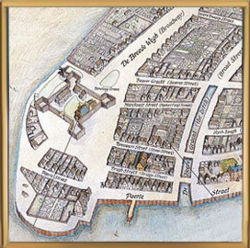| wiki | search |
Main Page | Groups and Assignments | Bios | History | Harlem | Diversity Today | Help
Colonial America | Early America | Modern America
New Amsterdam's People of Color
Slavery had existed in New York since its inception as New Amsterdam in the early 17th century. Upon arrival, slaves were already put to work. The Dutch West India Company had brought slaves from its other Atlantic settlements to develop the land. Also, due to a shortage of workers, blacks were also allowed to settle in New Amsterdam. These free blacks were given land above the colony and they would serve as a buffer from Native American attacks on the colony.
Slaves even enjoyed what was considered “half-freedom.” They were "free" when they were not working for their masters. For example, some slaves successfully petitioned for higher wages. Other slaves were able to buy their freedom through years of hard work. Finally, some were granted freedom in reward for good service and loyalty. Once freed, they were given tracts of land to tend. However, they were expected to pay a yearly tax on their crops and livestock and faced a return to slavery if they did not do so. More importantly, the children of freed slaves were still locked in servitude despite their parents' freedom. By the end of Dutch rule, one in five blacks were free.
Because of the failings of the colony, the Company later sent Peter Stuyvesant, to head the struggling colony. He believed that slave trade was a key to the economy of the colony. He actively sold slaves to other colonies and placed tariffs to try and keep private traders from cutting his slave trade profits. In the end, Stuyvesant’s and thus the Dutch's rule was over when the British sent a fleet of ships to take New Amsterdam. The change in leadership ended the Dutch Era and completely changed the definition of being black in New York.

